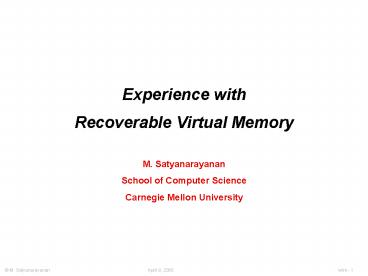Experience with Recoverable Virtual Memory - PowerPoint PPT Presentation
Title:
Experience with Recoverable Virtual Memory
Description:
primarily in Coda File System (large servers to tiny handhelds) Also used by others outside our ... runs on Linux, *BSD, MacOS X, and even WinXP (using Cygwin) ... – PowerPoint PPT presentation
Number of Views:33
Avg rating:3.0/5.0
Title: Experience with Recoverable Virtual Memory
1
Experience withRecoverable Virtual Memory
- M. Satyanarayanan
- School of Computer Science
- Carnegie Mellon University
2
Background
- RVM Recoverable Virtual Memory
- software library to provide transactional
properties for VM - in use since early 1990s
- primarily in Coda File System (large servers to
tiny handhelds) - Also used by others outside our group (not by
design!) - persistent garbage collection OToole et al
1993 - transactional distributed shared memory Feeley
et al. 1994 - persistent Java Jordan 1996
- Rio Vista transactional system Lowell Chen
1997 - Some questions
- What lessons have we learned from RVM?
- What is the role of the OS?
- How can hardware support help RVM?
3
Functionality
- Focus on A D of ACID (I provided by app)
- Segment
- persistent image of mapped data
- resides in file or raw disk partition
- Region
- all or part of a segment in active use
- area of an address space backed by RVM
- multiple regions per address space
- explicit mapping operations
map (region_desc, options_desc) unmap
(region_desc)
begin_transaction (tid, restore_mode) set_range
(tid, base_addr, nbytes) end_transaction (tid,
commit_mode) abort_transaction (tid)
flush ( ) truncate ( )
4
RVM Lessons
- Ability to treat VM transactionally is a BIG win
- especially valuable in failure handling in
distributed systems - encapsulates many messy details
- Both meanings of lightweight important
- small resource footprint
- easy to use
- Most of the value comes from very basic features
(KISS) - additional fancy features, complexity not worth
it - factoring out of isolation works well
- Log optimizations valuable in reducing log
traffic (20-60) - inter-transaction and intra-transaction
- no-flush transactions with explicit flush( )
calls useful
5
Role of OS
- RVM is a highly portable library
- absolutely no OS dependence (other than POSIX)
- runs on Linux, BSD, MacOS X, and even WinXP
(using Cygwin) - Lack of integration has performance consequences
- storage for segment distinct from swap space
- longer startup latency (fixable with private
mmap) - poorer paging performance
- Predecessor of RVM was tightly integrated with OS
- Camelot used many Mach mechanisms (e.g. external
pager) - stressed little-used OS features, many subtle
bugs - very complex to use, even more complex to debug
- potential win of OS integration not realized in
practice - Cant share regions across processes without OS
support - may be much more significant than performance
issues - prevents use of multiple address spaces for
robustness
6
How Can Hardware Help?
- Persistent RAM-speed log!
- would dramatically improve latency of log forces
- battery-backed memory ok, but brittle abstraction
- perhaps flash memory log device?
- (not important to integrate into address space)
- Avoid need for manual set_range( ) calls
- forgetting this is major source of programming
errors - page granularity not good enough has to be byte
granularity - perhaps get_ranges(tid) info from hardware?
- Isolation is completely orthogonal
- hardware concurrency control would fit easily
into RVM - separate portable Isolation library would be ideal































